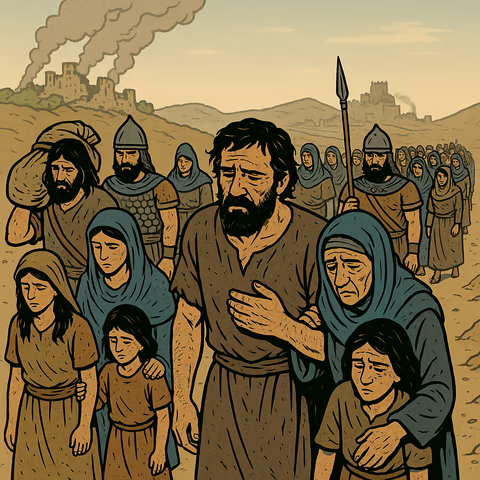
How Long Was the Babylonian Exile?
When was Jerusalem destroyed by the Babylonians? When did the exile begin and end? These might seem like simple questions, but they’re actually crucial for establishing accurate Bible chronology, translation, and for interpreting Bible prophecy.
You see, the Bible contains numerous prophecies and historical records that use the Babylonian exile as a reference point.
Overview
The Babylonian exile wasn’t a single 70-year period. Rather, it was several overlapping periods, including:
- Seventy years of Babylonian dominance (609-539 BC) — from Babylon’s defeat of Assyria until Cyrus’ defeat of Babylon (Jeremiah 25:11-12; Daniel 9:2).
- Seventy years of Yahweh’s rage (589-519 BC) — from the first siege of Jerusalem until the resumption of temple building under Darius (Zechariah 1:12; 2 Kings 25:1; Ezra 4:24).
- Fifty years without farming (587-537 BC) — corresponding to a full 50-year jubilee cycle, to ‘pay off its sabbaths’ (Leviticus 26:34-35; 2 Chronicles 36:20-21).
- Seventy years without a temple (586-516 BC) — from the destruction of Solomon’s Temple until the completion of the Second Temple (2 Kings 25:8-9; Ezra 6:15-18).
Jeremiah said that the first 70 year period (that of Babylonian dominance) would end, and then Yahweh will take revenge upon Babylon (Jeremiah 25:12; Daniel 9:2). This happened when Cyrus conquered Babylon in 539 BC.
Therefore, those first 70 years had already ended when Cyrus arrived; it did not (as some claim) end 2 years later when the Jews returned home in 537 BC. Counting back 70 years from 539 BC brings us to 609 BC, when Babylon defeated Assyria.
Understanding these distinct periods helps us establish accurate Bible chronology, and also corroborates the Bible with archaeological evidence.
Miller’s Misunderstanding

Many millions of people believe there was a single 70-year period of exile from 607 BC (when they say Jerusalem was destroyed) to 537 BC (when the Jews returned home). This view was popularized in the 1800s by William Miller, a Baptist preacher who made many end-times predictions.
Miller is most famous for once whipping up a frenzy of excitement when he predicted the Second Coming of Christ in 1844. Obviously, this failed to materialize.
However, several religions developed out of his movement, primarily the Seventh-Day Adventists. However, one later offshoot, the Jehovah’s Witnesses, continued using his chronology, maintaining his 607-537 BC dates for the exile.
However, Miller’s chronology creates some puzzling problems:
- It doesn’t match other biblical timeframes.
- It invalidates the other time periods mentioned in Scripture.
- It contradicts an enormous amount of archaeological evidence.
Here we explain where Miller went wrong, and present an alternative chronology which matches the Bible perfectly; further, it helps demonstrate that the Bible is true, accurate, and reliable.
Decoding the Biblical Detective Story
Let’s establish what the Bible says about these dates.
First, there’s Jeremiah’s prophecy about serving Babylon:
‘And you’ll serve that nation for 70 years…
As well as Babylon’s king.
And after the 70 years are fulfilled;
On the king of Babylon and his wicked nation,
I will then bring My vengeance
For the unrighteous things that they’ll do,’ says Yahweh.
(Jeremiah 25:11-12)
Did you catch that? The 70 years end when Babylon is called to account — which happened when Cyrus conquered Babylon in 539 BC. Well, if that’s when it ended, when did it begin?
You simply count back 70 years and you arrive at 609 BC. Did anything special happen in that year? Yes, that’s the year Babylon became the dominant world power. They finally defeated Assyria by conquering the ancient city of Harran, now in modern-day Turkey.
With this victory, Babylon finally defeated the Neo-Assyrian Empire; Babylon’s 70-year dominance over the entire Near-East, including Judah, had begun.
Now consider Daniel’s words, spoken at the end of this 70 years:
‘I, DaniEl, came to understand that the number of years (from Jehovah’s words given to the Prophet JeremiAh) for fulfilling Jerusalem’s desolation, [would be] 70 years’ (Daniel 9:2)
Daniel was reading the same words of Jeremiah that we quoted above. He was reading them after Babylon had fallen to the Medes in 539 BC (Daniel 9:1-2). He realized that this 70-year period had now ended; Yahweh had indeed taken vengeance on the King of Babylon, just as he had promised. Now the Medes were in control of Babylon, and the Jews were free to return home. Jerusalem could now be rebuilt!
Here’s where it gets interesting: There is more than just the 70 year period Daniel mentioned. If we look deeply into scripture, we find four distinct multi-year periods. Yes, and each has its own start and end point:
1. Seventy years of Babylonian dominance (609-539 BC).
2. Seventy years of rage (589-519 BC).
3. Fifty years of Sabbaths (587-537 BC).
4. Seventy years without a temple (586-516 BC).
Let’s map these out…
Timeline
609 BC
Babylon Defeats Assyria
Babylon becomes the dominant world power after defeating Assyria at Harran, marking the start of the 70 years of Babylonian dominance (Jeremiah 25:11-12).
605 BC
Nebuchadnezzar is King
Nebuchadnezzar inherits the Babylonian throne from his father, Nabopolassar.
602 BC
Judah Rebels Against Babylon
After serving as Nebuchadnezzar’s vassal for three years, King Jehoiakim rebels against Babylon and is taken away to Babylon in chains; temple treasures are also taken to Babylon. (2 Kings 24:1; 2 Chronicles 36:5-7)
At some point after this, Daniel and other Judean nobles are recruited for training in Babylon. This is not one of the mass deportations, but rather a program only for the most elite young Judean men. (Daniel 1:1-2)
5 years pass…
597 BC
First Deportation
Jehoiakim dies in Babylon, and back in Judah, his son Jehoiachin is installed as king. However, after just 3 months of his reign, Babylon attacks Jerusalem and takes Jehoiachin prisoner.
King Jehoiachin, nobles, and skilled craftsmen (about 10,000 people) are taken to Babylon. The temple treasures are seized, but Jerusalem remains intact.
The Babylonian’s then took Jehoiachin’s uncle, MatThaniAh, renamed him Zedekiah and installed him as king.
8 years pass…
589 BC
An Attack on Jerusalem
Pharaoh’s army marches out from Egypt, presumably in an attempt to assert control over Judah or the region in general. In response, Nebuchadnezzar attacks and possibly lays siege to Jerusalem, perhaps to ensure it will not rebel, but soon the Babylonians withdraw to meet Pharaoh’s army.
However, Jeremiah prophesied that the Egyptians would retreat and the Babylonians would later return to destroy Jerusalem. This earlier, brief siege marks the start of the 70 years of rage (Jeremiah 37:5-8).
588 BC
Zedekiah Rebels Against Babylon
Despite swearing an oath of loyalty to Nebuchadnezzar, King Zedekiah rebels against Babylon (2 Kings 24:20; 2 Chronicles 36:13).
Tevet (January/February), 587 BC
Babylon Returns and Sieges Jerusalem Again
Nebuchadnezzar returns and lays siege to Jerusalem.
This begins the 50 years of Sabbaths, where the land was not farmed (2 Kings 25:1; Jeremiah 39:1). We presume that the presence of the Babylonian army (and possible looting, etc.) in the land prevented the spring planting season.
Tammuz (June/July), 586 BC
City Walls Breached
After approximately 17 months of siege, the walls of Jerusalem are finally breached (2 Kings 25:2-4; Jeremiah 39:2).
Av (July/August), 586 BC
Temple Destroyed; Second Deportation
Nebuzaradan, captain of Nebuchadnezzar’s guard, burns Solomon’s Temple and destroys Jerusalem. Most remaining Jews are deported to Babylon in this second major deportation.
This begins the 70-year period without a temple (2 Kings 25:8-11; Jeremiah 52:12-16). Jerusalem is now abandoned.
Late 586 BC ?
Gedaliah Appointed Governor
At some point after Jerusalem’s destruction, Nebuchadnezzar appointed Gedaliah as governor over the remaining poor people in Judah. He governed from Mizpah, not Jerusalem (2 Kings 25:22-24; Jeremiah 40:7-12). It is assumed that this was soon after the destruction of Jerusalem; the exact date is not recorded.
About 4 years pass…
582 BC
Final Third Deportation to Babylon
Governor Gedaliah is assassinated. Most of the remaining Jews flee to Egypt, fearing Babylonian reprisal. Those who stay behind are taken to Babylon in a final, smaller deportation. Jerusalem and Judah are now completely abandoned (2 Kings 25:25-26; Jeremiah 41:1-3, 16-18, 52:30).
43 years pass…
539 BC
Fall of Babylon
Cyrus conquers Babylon, fulfilling Jeremiah’s prophecy. The 70 years of Babylonian dominance are over. (Daniel 5:30-31; Jeremiah 25:12).
537 BC
Jews Return Home
The first group of exiles returns to Jerusalem under Zerubbabel, the first inhabitants for 45 years (Ezra 1:1-4, 2:1-2).
This marks the end of the 50 years of Sabbaths.
18 years pass…
519 BC
End of Yahweh’s Rage
The 70 years of rage end, as recorded in Zechariah’s prophecy. This period began when Jerusalem was first besieged (589 BC) and ended when the temple rebuilding resumed under Darius, marking Yahweh’s renewed favor toward Jerusalem (Zechariah 1:12-17).
516 BC
End of 70 Years Without a Temple
The 70 years without a temple finally end at the dedication of the Second Temple. This period began when Solomon’s Temple was burned in 586 BC and concluded when temple worship was fully restored, exactly 70 years later (Ezra 6:15-18).
Seventy Years, Several Stories
Each time period serves a distinct purpose in telling the story of Israel’s exile and restoration. Let’s examine each one:
1. Seventy Years For Babylon (609-539 BC)
This period began when Babylon defeated Assyria at Harran, becoming the dominant world power, and ended with Babylon’s fall to Cyrus.
Yahweh said:
‘And you’ll serve that nation for 70 years…
As well as Babylon’s king.
And after the 70 years are fulfilled;
On the king of Babylon and his wicked nation,
I will then bring My vengeance’
(Jeremiah 25:11-12)
‘After the 70 years
Upon Babylon have been fulfilled,
I’ll come to visit and do as I said…
I’ll bring you people back to your [homes].’
(Jeremiah 29:10)
True to this prophecy, Babylon’s dominance lasted for exactly 70 years before Cyrus conquered Babylon. This is the period Daniel was reading about when he realized it was time for Jerusalem to be rebuilt.
2. Seventy Years of Rage (589-519 BC)
This period began when Babylon first attacked Jerusalem (Jeremiah 37:5-8) and ended when the temple reconstruction resumed under Darius (Ezra 4:24, 5:1-2). Zechariah marks this period:
‘O Yahweh of Armies,
How long will you fail to show mercy
On JeruSalem and the cities of Judah?
For, this is the 70th year of Your rage.’
(Zechariah 1:12)
The answer came with the resumption of temple building, showing that Yahweh’s anger had ended. Note that other Bible translations may call this period 70 years of denunciation.
3. Fifty Years of Sabbaths (587-537 BC)
This 50-year period represents the time when Judah’s land was not farmed.
It started when Babylon began its siege of Jerusalem in 587 BC, and ended when the first exiles returned under Zerubbabel in 537 BC. This fulfilled the prophecy about the land enjoying its sabbaths:
‘Meanwhile, the ground will enjoy its Sabbaths during all the time that it’s empty.’ (Leviticus 26:34)
Why 50 years? Because this period aligned perfectly with Israel’s Jubilee cycle (Leviticus 25:8-12)!
Yes, every 50th year was supposed to be a Sabbath year when the land would rest completely (Leviticus 25:4-5). By allowing the land to lie desolate for exactly one Jubilee period (50 years), it made up for all the Sabbath years that had been violated. When the Medes came and ended the related 70 year period, the planting of crops could begin again when the Jews returned home (see 2 Chronicles 36:20-21).
The timing was no coincidence! The Jews’ return in 537 BC marked the end of a Jubilee cycle (Leviticus 25:10), symbolizing a fresh start and release for both the people and the land.
Why would planting cease as soon as Jerusalem was besieged? The Bible doesn’t say; probably because it’s obvious that the Babylonian army would have been looting and burning across all of Judah, in addition to the capital city being besieged. The economy was likely destroyed.
Indeed, while 2 Kings 25:12 reports that a small group of vineyard workers and farmers remained in the land, it does not mention them planting new crops. And why would they? With a greatly diminished population and no cities, who were the customers? Also, in pre-industrial times, planting and harvest time involved the entire community, not just a few individuals. Mass planting and harvesting were simply no longer possible. Israel’s agricultural industry was finished.
Farming likely went from being the dominant national industry to a few plots or gardens for personal use.
Indeed:
- The Bible reports that Gedeliah encouraged Jews who had previously fled to Edom to move back into Judah and to bring their harvests of wine, fruit, and olive oil back with them. (Jeremiah 40:10-12)
- There is also a brief mention of some men from neighboring Samaria bringing staples of wheat and barley into Judah (Jeremiah 41:8).
So we argue that mass agriculture likely ceased upon the Babylonian attack in 587 BC, and that the land had indeed begun to ‘pay off’ its Sabbaths, just as Yahweh foretold.
Then, after Gedaliah’s assassination, all remaining Jews either fled to Egypt or were taken away to Babylon. The land was now completely abandoned, and continued to be reclaimed by the wilderness.
4. Seventy Years Without a Temple (586-516 BC)
This 70-year period began when Nebuchadnezzar’s forces burned Solomon’s Temple in 586 BC, and ended with the completion and dedication of the Second Temple in 516 BC.
The rebuilding process faced many challenges (Ezra 4:1-5, 24), but 70 years after its destruction, the new temple was dedicated and full worship resumed (Ezra 6:15-18).
This period is not explicitly named as a 70-year period in the Bible, it’s just what we see when we work out the chronology.
Digging Up the Details: Archaeological Evidence
The events and dates we’ve outlined align very well with archaeological findings. Here are some key pieces of evidence:
-
The Fall of Nineveh Chronicle records Babylon’s defeat of Assyria at Harran in 609 BC, confirming the start date of Jeremiah’s prophecy about Babylon’s 70-year dominance (Jeremiah 25:11-12).
-
The Babylonian Chronicles document events recorded in 2 Kings and Jeremiah:
- Nebuchadnezzar’s campaigns against Jerusalem (2 Kings 24:1-2).
- The capture of Jerusalem and deportation of Jehoiachin in 597 BC (2 Kings 24:10-16).
- The final destruction of Jerusalem in 587/586 BC (2 Kings 25:8-11; Jeremiah 52:12-16).
-
Business Tablets from Babylon confirm details from 2 Kings and Jeremiah:
- Jewish exiles receiving rations, just as the Bible records (2 Kings 25:27-30).
- King Jehoiachin and his sons in Babylon (Jeremiah 22:24-30).
- Various Jewish names and settlements, showing the reality of the exile (Jeremiah 29:1-7).
-
The Cyrus Cylinder confirms prophecies about Persia’s conquest:
- Cyrus’s conquest of Babylon in 539 BC (Daniel 5:30-31).
- His policy of allowing exiled peoples to return home (Ezra 1:1-4; Isaiah 44:28).
- The restoration of temples and worship (2 Chronicles 36:22-23).
This archaeological evidence provides independent confirmation of the biblical timeline, showing how Scripture and history align perfectly when we understand the different time periods correctly.
Myths and Misses
Why do so many people misunderstand these periods? It often comes down to these myths and misconceptions:
Number of Time Periods
Many believe there was just one 70-year period.
However, the Bible mentions two overlapping 70-year periods:
- That of Babylonian dominance mentioned in Jeremiah/Daniel and,
- The period of rage (denunciation) mentioned in Zechariah.
In addition, there is:
- A 50-year Sabbath period (of one Jubilee cycle) without farming,
- And there happened to be 70 years without a temple (586-516 BC).
Starting Point Confusion
Some try to count from when the temple in Jerusalem was destroyed. But since Jeremiah’s prophecy ends when Babylon is conquered in 539 BC (Jeremiah 25:12), it must begin 70 years earlier, in 609 BC. That’s exactly when Babylon conquered Assyria — not when Yahweh’s Temple was destroyed (in anyone’s timeline).
Length of Exile
Some may ask, ‘Wasn’t everyone in exile for 70 years?’ Actually, no! Nobody’s chronology allows for that.
After Jerusalem fell, a very small group of Jews remained in the surrounding land under the governorship of Gedaliah (2 Kings 25:22-24; Jeremiah 40:7-12). However, this new governor did not live in Jerusalem — which remained desolate — but rather in Mizpah, a few miles north of Jerusalem (Jeremiah 40:6-8). It wasn’t until his assassination four years later, and the subsequent flight to Egypt (2 Kings 25:25-26; Jeremiah 41:1-3, 16-18), that the land became truly empty and ‘everyone’ was in exile.
In other words, even if one accepted William Miller’s 607 BC date, there was no 70 years of Judah and Jerusalem being uninhabited with everyone in exile; at most it could be 65 years. If you accept our 586 BC date, Jerusalem was abandoned for 50 years, and Judah was uninhabited for 45 years.
Did Josephus Support 70 Years?
Some report that the Jewish historian Josephus supports the idea of Jerusalem being desolate for 70 years.
Writing in the 1st century AD, he said:
‘…all Judea and Jerusalem, and the temple, continued to be a desert for seventy years.’
(Josephus, Antiquities of the Jews, 1.9.7)
However, in a later book, Josephus states that the desolation lasted for 50 years!
He writes:
‘Nabochodonosor in the eighteenth year of his reign devastated our temple, that for fifty years it ceased to exist.’
(Josephus, Against Apion, 1.21)
He also mentions that the 50 years agrees with both the Babylonian historian Berossus and ‘our books’ (the Bible). This suggests that Josephus was trying to correct his earlier statements.
However, he was still confused! The 50 years was how long Jerusalem was abandoned, not the length of time without a temple!
Interestingly, the translator of Josephus’ works, William Whiston, noted that Josephus often revised his chronological calculations in later works.
We should also remember that Josephus wasn’t writing from firsthand experience — he lived over 600 years after these events. He was simply interpreting the same biblical texts we have today, and it seems that he got confused about the details.
Time-Travel Takeaways
Why does any of this matter today? Because understanding these overlapping periods helps us in these ways:
It Helps With Bible Translation
We, as Bible translators, must understand the chronology of the Bible so we can translate it accurately. Misunderstanding the chronology may lead to errors, or even to bias and the deliberate mistranslation of key verses.
It Warns Us Against Making Predictions
William Miller and groups that descended from him have made several failed predictions based on his chronology. This can be a lesson to us to not make predictions based on our own understanding of the Bible.
It Helps Us Trust Biblical Accuracy
The exact alignment of these periods with both Scripture and archaeology, shows the Bible’s historical reliability. You don’t have to choose between faith and facts as they work together.
Prophecy Becomes History
Would you believe that the exile was predicted centuries before it happened? Yes! Way back in the time of Moses, Yahweh gave an incredibly detailed warning about what would happen if Israel broke His covenant:
‘If you choose not to listen to Me and obey My rules… If you disobey them and your inner person comes to dislike My decisions… If you don’t keep all My Commandments and if you break My Sacred Agreement…’
‘For I’ll scatter you among the nations… You will be attacked with swords and destroyed, and your land and your cities will be emptied!’
‘Meanwhile, the ground will enjoy its Sabbaths during all the time that it’s empty… Yes, that’s when the land will enjoy its Sabbaths… During all the time that it’s empty! For it’ll keep the Sabbaths that weren’t kept when you lived there.’
It predicted:
- The scattering of the people among other nations,
- The emptying of their cities,
- The desolation of their land,
- That the land would ‘enjoy its Sabbaths’,
- That this would make up for Sabbath years they failed to observe.
Every detail came true! And that’s just one part of this very long prophecy.
Yet there’s even more. Through Jeremiah, Yahweh revealed not just that exile would come, but its exact duration and outcome. He even named Babylon as the nation that would take them captive (Jeremiah 25:8-11).
Even more remarkably, Isaiah named Cyrus as their deliverer — 150 years before he was born:
‘I’m the One who’ll say this to Cyrus:
‘Think first and then you must do
All the things that I’ll tell you to do.
For JeruSalem must be rebuilt,
And My Temple’s foundation must be laid.’
(Isaiah 44:28)
This wasn’t just history — it was prophecy unfolding before their eyes!
Life in Babylon
What was life like for the Jewish exiles in Babylon? It wasn’t all hardship! In fact, Jeremiah advised them to:
‘Build houses and get ready to live there…
Plant gardens and then eat their fruits…
Take wives and also have children…
Father both daughters and sons!’
‘Then, take [mates] for your daughters and sons;
And they’ll also give birth to daughters and sons…
They’ll multiply and not be reduced!’
‘Yes, seek peace in the land where I’ve sent you,
And pray to Jehovah on its behalf;
For, in its peace, you’ll find peace!’
(Jeremiah 29:5-7)
Many Jews prospered in Babylon. Daniel rose to high government office. Ezekiel ministered as a prophet among the exiles. The Babylonian Talmud tells us that great schools of Jewish learning developed there.
This period saw major developments in Jewish religious life:
- The rise of synagogues as centers of worship and learning.
- The emergence of scribal traditions to preserve Scripture.
- A renewed emphasis on Sabbath observance and dietary laws.
- The collection and preservation of sacred texts.
The Persian Promise
When Cyrus conquered Babylon in 539 BC, it marked a dramatic turning point. Here’s what happened:
‘In the 1st year of King Cyrus of Persia …[Cyrus] sent a written proclamation throughout his kingdom that said:
‘This is what Cyrus the king of Persia has decreed:
‘All the kingdoms of the earth have been given to me by Jehovah, the God of the heavens, and He told me to build a Temple to Him in JeruSalem of Judah. 3So, who of you are His people? His God Jehovah is now with him!’
‘Therefore, let him [return to JeruSalem] and build a Temple for the God of IsraEl who is The God in JeruSalem.’
(Ezra 1:1-3)
The Cyrus Cylinder, discovered by archaeologists, confirms this policy of allowing conquered peoples to return home and rebuild their temples.
But it wasn’t just Cyrus. Later Persian kings played crucial roles:
- Darius I confirmed and strengthened Cyrus’s decree (Ezra 6:1-12).
- Artaxerxes I sent Ezra to restore proper worship (Ezra 7:11-26).
- Artaxerxes I later sent Nehemiah to rebuild Jerusalem’s walls (Nehemiah 2:1-8).
Frequently Asked Questions
Why did God allow the exile to happen?
The exile was a consequence of breaking the covenant, particularly:
- Idolatry and false worship (Jeremiah 7:30-34).
- Social injustice (Jeremiah 22:13-17).
- Failure to observe Sabbath years (2 Chronicles 36:21).
- Refusing to heed prophetic warnings (2 Chronicles 36:15-16).
Why didn’t all Jews return to Jerusalem?
Many Jews had established successful lives in Babylon. The Talmud suggests that only the most religiously committed returned. Major Jewish communities remained in Babylon for centuries.
What happened to the Ark of the Covenant?
The Bible doesn’t tell us directly. According to Jewish tradition (in 2 Maccabees 2:4-8), Jeremiah hid it before the exile. The Second Temple didn’t contain the Ark, and its ultimate fate remains one of history’s great mysteries.
Why these specific time periods?
Each period served a distinct purpose:
- 70 years of dominance fulfilled God’s decree about Babylon’s rule.
- 70 years of rage marked the time of divine punishment.
- 50 years without farming allowed the land to ‘rest’ for a complete Jubilee cycle.
- 70 years without the temple could be seen as a complete cycle of judgment and restoration.
Did everyone suffer during the exile?
No! Many Jews prospered in Babylon, following Jeremiah’s advice to build houses and plant gardens (Jeremiah 29:5-7). Daniel and his friends reached high positions in government, and Jewish communities established successful businesses and schools.
Biblical Chronology
 Bible Chronology Based on the Septuagint
Bible Chronology Based on the Septuagint Who Was Pharaoh in Exodus?
Who Was Pharaoh in Exodus? How Long Were the Israelites in Egypt?
How Long Were the Israelites in Egypt? How Long Was the Babylonian Exile?
How Long Was the Babylonian Exile? When Bible Chronology Goes Wrong
When Bible Chronology Goes Wrong
Also see our Articles index and our About section.